Aquaculture is the breeding, hatching, culturing or harvesting of aquatic organisms. It is similar to agriculture, but involves marine plants and animals instead of land based crops and livestock.
The primary purpose of aquaculture is to produce food for human consumption and other commercial products, but it can also be used to restore habitats and replenish populations of threatened and endangered species.
Current status and outlook
Aquaculture is the world’s fastest growing food production sector, driven by the dual forces of:
- rising global demand for food due to population growth;
- decline in availability of finite wild fish stocks due to commercial fishing.
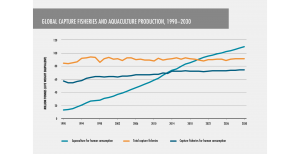
Global capture fisheries and aquaculture production, 1990-2030,
Food and Agriculture Organization of the United Nations
It is increasingly more likely that seafood eaten around the world today was commercially farmed, rather than caught in the wild. Currently, about 50% of global seafood production comes from aquaculture, and this figure is expected to grow to 62% by 2030.The global human population is set to reach almost 10 billion by 2050, which equates to a 52% increase in demand for protein. Given that fish and other aquatic organisms are a finite resource and that overfishing of our oceans is already occurring in parts of the world, aquaculture presents an opportunity to sustainably meet the needs of future generations.
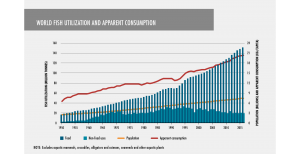
World fish utilization and apparent consumption,
Food and Agriculture Organization of the United Nations
Note: ‘Non-food uses’ include the production of fishmeal and fish oil, aquaculture and livestock feed, breeding stock, bait, pharmaceutical use and ornamental use.
Compared to other farmed animals, aquaculture is highly resource efficient. Seafood has the highest protein retention compared to other sources such as chicken, pork or beef. It also has a low feed conversion compared to other forms of protein and results in lower greenhouse gas emissions than other types of farming.
The two tables below show the most commonly farmed species around the world, by volume and value.
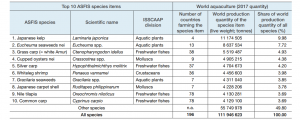
Top 10 farmed species by quantity in world aquaculture, 2017
Food and Agriculture Organisation of the United Nations
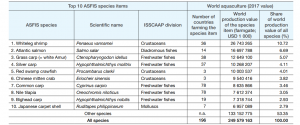
Top 10 farmed species by value in world aquaculture, 2017.
Food and Agriculture Organisation of the United Nations
Most aquaculture species are produced primarily for direct human consumption, such Whiteleg shrimp, Japanese kelp and Atlantic salmon. However, some aquaculture species have other uses in addition to this. For example, Eucheuma seaweeds are used for the production of carrageenan, an ingredient in cosmetics, manufacturing and food processing, while many freshwater species, such as trout, are also
bred as stock to support recreational fishing. Gracilaria algae is a common species cultivated for the aquarium trade, and some marine species are used for medical research and treatment.
Australia’s position
The demand for seafood in Australia has been steadily increasing for the past 30 years, and current consumer demand exceeds domestic supply. Aquaculture has the potential to meet this demand. Since 2002–03 the gross value of aquaculture production in Australia has increased by 12% to over $1 billion. In 2017–18, it accounted for 45% of the total value of Australian fisheries production.
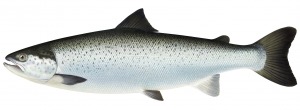
The largest Australian aquaculture industry sector is Atlantic salmon in Tasmania. Farmed Tasmanian
Atlantic salmon has also surpassed the wild caught Western Rock Lobster fishery as Australia’s highest
valued commercial fishery. Illustration © R.Swainston/www.anima.net.au
The top five aquaculture species groups in Australia, in order of production value, are: salmonids (salmon and trout), tuna, edible oysters, pearl oysters and prawns. Other species groups grown in Australia include: abalone, freshwater finfish (such as barramundi, Murray cod, silver perch), brackish water or marine finfish (such as barramundi, snapper, yellowtail kingfish, mulloway, groupers), mussels, ornamental fish, marine sponges, mud crab and sea cucumber.
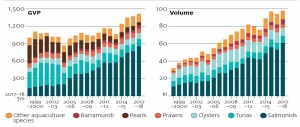
Aquaculture GVP (gross value of production) and volume by major species group, 1998–99 to 2017–18.
Source: Australian Bureau of Agricultural and Resource Economics and Sciences
Australian aquaculture production is largely based in regional Australia and makes a significant and positive contribution to regional development.
Australia’s aquaculture industry is small by global standards, however it has many advantages over its competitors, notably:
- a range of climatic zones, allowing for cultivation of diverse species;
- access to relatively inexpensive land and water;
- capacity to grow most ingredients required in high quality fish diets, at competitive cost;
- absence of many of the diseases that affect aquaculture in other countries.
Sustainability issues: managing issues and threats
Although aquaculture is an important practice in ensuring global food security, there are a number of potential issues to overcome:
- altered food webs (especially in cases where selectively bred species might escape into the wild);
- wastes from uneaten food, faecal, urinary and other products associated with raising animals affecting water quality and sediments;
- transfer of pathogens diseases and parasites to wild populations;
- introduction of exotic and genetic material into the environment;
- contamination of seafood by poor water quality, use of antibiotics, growth hormones or pesticides used in growing feeds;
- over-exploitation of wild fish, caught to produce fishmeal and fish oil as feed for cultured species;
- overfishing and bycatch associated with harvesting of larvae, postlarvae, or gravid females from the wild (to be later raised as farmed species) – this represents losses to capture fisheries and biodiversity;
- loss or destruction of critical habitats such as mangroves, seagrass beds and wetlands following from the construction of artificial cages, tanks and other infrastructure associated with aquaculture.
It must be stressed that these issues are primarily a concern in countries which lack appropriate regulatory control. Vigilance, ongoing research and technological development help to manage and minimise these threats. Farming practices need to be inherently sustainable because a healthy environment is essential to successful production, and the global growth of aquaculture reflects a trend towards continuous improvement.
References
Department of Primary Industry and Resource Development, Aquaculture development plan – draft, aquaculture_development_plan_draft
Department of Primary Industry and Resource Development, Aquaculture position paper, aquaculture_position_paper
Aquaculture Alliance, http://www.aquaculturealliance.org
Worldwide Aquaculture, Aquaculture and fish farming impacts on environment, http://www.worldwideaquaculture.com/aquaculture-and-fish-farming-impacts-on-environment/
Department of Agriculture, Water and the Environment, Aquaculture industry in Australia, http://www.agriculture.gov.au/fisheries/aquaculture/aquaculture-industry-in-australia
Food and Agriculture Organisation of the United Nations, Top 10 species groups in global aquaculture 2017, CA5224EN
Australian Bureau of Agricultural and Resource Economics and Sciences, Australian Fisheries and
Aquaculture Statistics 2018, AustFishAquacStats_2018_v1.0.0
